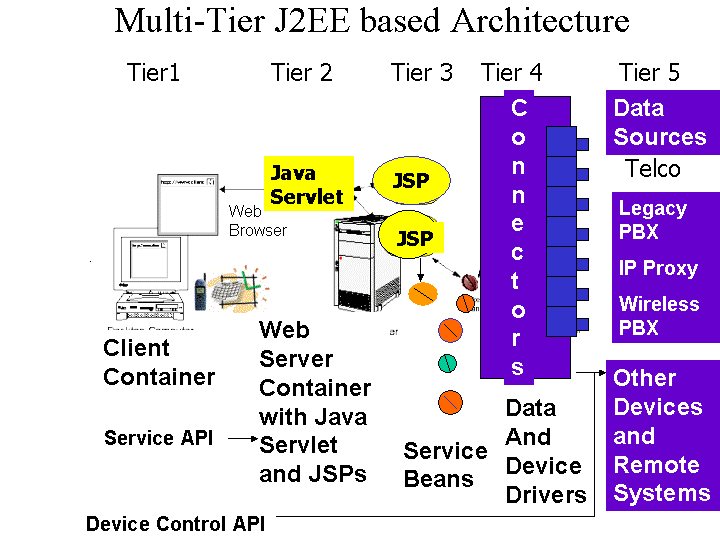Tier 1 Client Tier communicates via XML based service API, client can be:
-a partner application running on a workstation
-Web Browser with JavaTM Applet
-Wireless device with embedded WML browser or VoiceXML interpreter
-Java card technology device
Tier 2 Web Server Container with J2EE Servlet and JSP engines where servlet is responsible for session tracking and request distribution, and JSPs provide presentation layer back to the client.
Tier 3 worker beans providing services
Services-Worker beans can be (not necessary) implemented as EJBs to gain advantage of security and transaction monitoring services provided by EJB containers
Tier 4 Connectors to Data Sources, Remote Systems, and Devices
A Data Source model was created to describe multiple HR/ER data sources with their types, rules, and structure using XML descriptors.
A unified approach was used to connect to all data sources using Java Naming and Directory Interface (JNDI). A Data Source interface was implemented for RDBMS, LDAP, file structures, directory services, and DNS systems.
A master controller is created to describe a set of operations on telecom systems.
Telecom XML based device control API is implemented for drivers providing control on legacy PBX, IP, and wireless communication systems.
Tier 5 Data Sources and Remote Systems
Telecom systems like PBXs, Voice Mail Systems, etc, other remote devices, and systems.
Data connectors and device controllers (Tier 4) communicate to Data sources, remote devices, and systems via XML based Device Control API
Back To Basic Steps
5. Recognize Reusable Services and Shared Data
Look for reusability from two points of view: within an application and throughout multi-application environment.
Reusable code should be well understood and perfectly commented.
The examples below can give an idea about candidates for reusable services and shared data.
- 5.1 REUSABLE SERVICES
Security Services
Taking into account multi-platform implementation this service belongs to the client or presentation side and is implemented differently for different platforms.
For example it's reasonable to use for UNIX systems "whoami" - UNIX system call to return System User ID.
For Windows systems an additional LOGON - dialog window can appear prompting a user for USER ID and PASSWORD. If PASSWORD matches USER ID, this implementation also returns User ID.
- Cache some data while starting application
This service is used to cache some database tables into memory for multi-user usage. This is a good place to recognize data that can be shared in multi-user application.
- ExecuteDynamicQuery
This service is executing SQL statement stored dynamically into the Text Data and passed as an argument to the method. It returns result data from database in a format presented by another input argument.
5.2 SHARED DATA
Two types of shared data should be recognized:
- client shared data,
data shared between layers or screens within the application. This kind of data can serve as common interface and should be stored (cached) on the client side. Each user/client works with its own set of the client shared data.
- multi-user shared data,
data shared by many users, like statistics or short database tables. This kind of data should be stored on the server side as a unique copy that can serve to all the users running this application.
It is recommended to define specific classes for shared data and introduce proper methods operating on the data. Statistics can be an example of such a class. Statistics being organized as shared data gives inexpensive opportunity real time review an application usage
Reusable Services operating on Statistics give an idea about Multi-User shared data usage. Statistics services can be fired when any user starts or closes an application. Then the major results are immediately available to all the other users on line. It helps to collect Statistics (shared data) on how many users are looking into the application and for what reason for example for review or to modify data.
Client shared data operations are expect to be more specific to an application and not necessary (but willingly) are reusable.
5.3 SCREEN REUSABILITY
Components of User Interface or Widgets, like data fields, buttons and others also can be considered as source of reusability especially for a high density screens.
Current tools allow dynamically change widget state from visible to invisible, from active to inactive, change color, label name and so on.
This technique helps to make widgets multi-functional and reusable.


